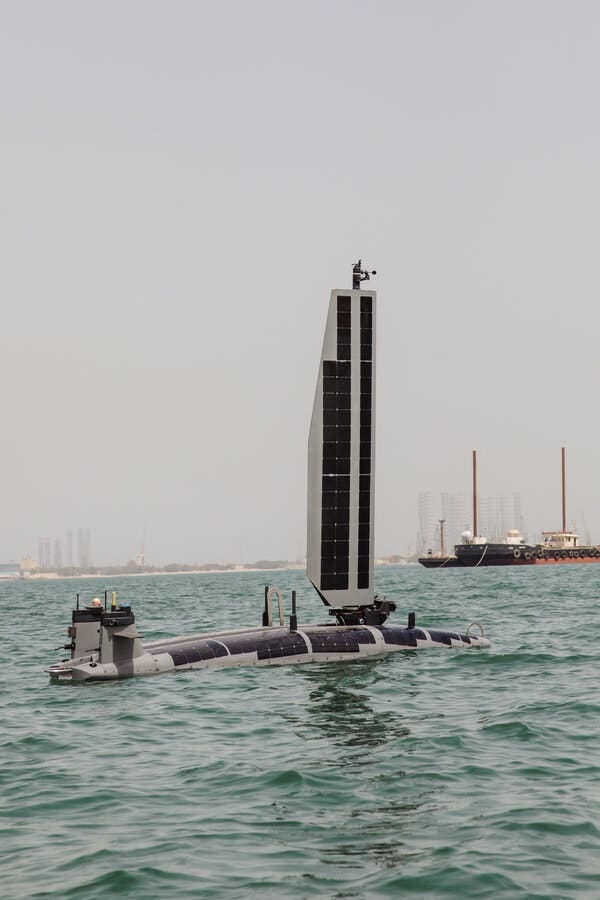All through the weekend and in to my Labor Day Weekend Monday, a whole raft of wonderful people great and small asked me to weigh in on Eric Lipton’s article in NYT, Faced With Evolving Threats, U.S. Navy Struggles to Change.
My dear and lovely friends, please allow me and mine our bank holidays. There is family gossip to discuss and create, dogs to be taken on very long walks, adult beverages to be sampled, food one must not eat to be eaten, and the concept of the lotus-eater indulgence of the afternoon nap to be addressed.
Of course, this is in a NYT article and seemed, at first blush, to be what I and other navalists have been waiting for - a narrow-band signal high above the ambient noise that people who otherwise are not tracking our concerns will hear.
You may not like it, but the simple fact is that even the most important people with hands on the levers of power only have a 24-hr day. They mostly live and work - or rely on those who do - somewhere along the Acela Corridor. As such, if it isn’t in WaPo or NYT, better than average bet they won’t see it.
Every time a significant article in NYT or WaPo comes out about things close to the navalist’s heart - you damn sure better read it.
Be careful though, your are likely not to be all that pleased with what you will read.
I learned long ago to try to ignore the title of articles as authors don’t usually create the title of their works, so I did my best not to get triggered by the title, but alas … it fits.
I did start off optimistic though.
The cover pic is that icon of American naval power, the glorious monument to the best of what American has to offer, the Huntington Ingalls complex in Pascagoula, Miss. … and it all went mostly downhill from there except for a couple of pleasant surprises.
Refresh your cup of coffee and let’s dive in.
…the focus from Washington on producing a stream of new warships is also creating a fleet that some inside the Pentagon think is too wedded to outdated military strategies and that the Navy might not be able to afford to keep running in decades to come.
There it is, the 3rd paragraph in and I can tell we have not what we wanted … no belay my last … what we needed. No, not even close. We don’t have a “stream” of new warships … more of a brook.
I thought this article would be a solid contribution to the effort that started to get traction inside the last 18-months. A lot of effort has been made to get in to the larger information space the critical shortfall in shipyard building and maintenance capability and capacity the US Navy must fix if we are going to be able to meet the challenges west of the International Date Line.
That isn’t what we are getting with Lipton’s article. Just the opposite. Even worse than negative-help, that first pull-quote above is your I&W that we are about to be fed a dish of recycled talking points, vision, and just bad thinking from the Age of Transformationalism we’ve spent the better part of two decades at the OG Blog and here debunking and warning about.
Bad ideas that never result in bad consequences for those who promote them will always return. There is something very seductive in selling - and buying - ideas that auto-slather you with a sheen of enlightenment, promising an offramp of progressive enlightened hope that allows you to avoid the very real hard work and stewardship that is facing you on the road ahead. Why work hard now on something that can be measured, tested, and evaluated that even if it works out will only bring praise on people in the future who will have your job after you?
Why not take the hosannahs and panel invites today with your Tomorrowland Vision of Excellence that makes everyone feel great - but can’t be measured until the “out years” where you’ll be doing other, more prosperous activities? If there are problems, other people in the future you will have your job after you will work it out. Pick your rate, pick your fate, etc.
So, you know where this is going, right? The people in the above paragraph who read too much military fiction written “in the near future” just love them some … well …
Operating on a budget that was less than the cost of fuel for one of the Navy’s big ships, Navy personnel and contractors had pieced together drone boats, unmanned submersible vessels and aerial vehicles capable of monitoring and intercepting threats over hundreds of miles of the Persian Gulf, like Iranian fast boats looking to hijack oil tankers.
Yes, the low sea-state float toys … when things heated up recently in the waters off Iran, how did those thing do?
Of course, they did nothing. What did the Navy do? The only thing that actually is effective in the face of aggression at sea; Sailors, Marines, and Airmen.
There are some people who will never let reality get in the way of a pet theory.
Now they are pleading for more money to help build on what they have learned.
“It’s an unbelievable capability — we have already tested it for something like 35,000 hours,” said Michael Brown, who was the director of the Defense Innovation Unit, which helped set up the unmanned drone tests in Bahrain. “So why are we not fielding that as fast as possible?”
Perhaps because it is a niche capability that was measured and found wanting outside its weight class in permissive peacetime Southwest Asia and there is not enough memory in Christendom to store the number of Planning Assumptions one would need to have these be effective in any fight west of the International Date Line.
Perhaps.
This?
Also, a quote from the former director of the Defense Innovation Unit? Isn’t that like asking a Chevy dealer what is so great about the Silverado? Asking a cattleman the benefits of beef? The lady in the pink Cadillac the joys of lots of makeup?
I’m sorry everyone, but I’m not sorry if you take this personally; but the following this is pretty much what is on the right rear quarter panel behind the Watusi.
At no moment since World War II has the service faced a more urgent demand to embrace new technologies and weapons systems, given the rising threat from a now formidable Chinese military.
This is standard industry boilerplate for the last few decades talking us in to “divest in what we have to invest in what I promise” that got us in to the mess we are in right now.
The “…now formidable...” really? How did they get “formidable"? This did not happen overnight. We got here in earnest during the Coffee Klatch Era during the Clinton White House. Then we got distracted for two decades trying to build civil societies from nations who were not civil … and now we have a crisis we have to slap new names on old Rumsfeldian ideas to?
Hard pass.
But the Navy, analysts and current and former officials say, remains lashed to political and economic forces that have produced jobs-driven procurement policies that yield powerful but cumbersome warships that may not be ideally suited for the mission it is facing.
Oh, really? Define “the mission” for me. Detail for me “cumbersome.” Do that, then we’ll discuss your tinker toys.
An aversion to risk-taking — and the breaking of traditions — mixed with a bravado and confidence in the power of the traditional fleet has severely hampered the Navy’s progress, several recently departed high-ranking Navy and Pentagon officials told The New York Times.
No. Now they’re just insulting the reader. This is 180-degrees out from the facts and historical record. It was the complete and intentional hand-waving of risk; technology risk; program risk; design risk; etc that put us where we are. We lost an entire generation of shipbuilding because we invested our very real capital, along with institutional capital, in the black holes of LCS, DDG-1000, CG(X), and are barely making use of FORD after drowning it with time and money.
“The U.S. Navy is arrogant,” said Lorin Selby, who retired this summer as a rear admiral and the chief of naval research after a 36-year career in which he helped run many of the Navy’s major acquisition units. “We have an arrogance about, we’ve got these aircraft carriers, we’ve got these amazing submarines. We don’t know anything else. And that is just wrong.”
OK, let’s head out to 10-DME and hold on this comment here. We need to pick apart a few things. Arrogant, sure - I’ve thrown similar words that way about everything from our maintenance to our airwing design for decades … but Lorin.
Lorin.
What did you used to do?
In his last Navy role, he served as the Chief of Naval Research, where he led a distributed team of 3800 personnel in developing leading edge technologies for the US Navy and Marine Corps, overseeing a $4B investment.
Your wiki page says you ran ONR until June 2023. So, that was your job less than 2-months ago?
What exactly did you do with your $4 billion?
Oh, I forgot to mention - that CV quote above? I got that from Selby’s bio from his new gig. He’s with WestExec Advisors. That’s Michèle Flournoy’s shop. Once you know that, a lot of the rest of the article starts to make sense.
Again, great and wonderful people in Flournoyistan, but in the context of this article that should be disclosed.
Just when I was getting weary, this bit came up. For some it reads like a, “industry bad. politicians bad” part of the article - but if you are a fact-based navalist, it reads as good and right.
Leadership on Pentagon budgets on Capitol Hill is dominated by lawmakers from shipbuilding communities like Senator Roger Wicker, Republican of Mississippi. The industry directs tens of millions of dollars of campaign contributions to key lawmakers and mounts lobbying campaigns pushing the Navy to build more ships.
Correct.
Capt. Alex Campbell of the Navy, whose job this year has been to find ways to buy cheaper, faster, more innovative technology, said the amount of money that had been allocated to the effort so far was minuscule.
…
Even as the big shipyards are booming, companies that make unmanned platforms like those being evaluated in Bahrain are struggling to remain afloat.
Which is about correct being that we have yet to find something that is survivable and useful in a peer battle at sea or can get to and operate in a contested environment west of the International Date Line.
Spend a little, learn a little, make better, prove better, spend more … profit.
To many analysts, industry executives and current and former military officials, the open question is how quickly the Navy can embrace the tactical opportunities by also arming itself with a new generation of weapons that are more maneuverable, cheaper to build and less devastating to lose.
So tiresome. “cheaper, faster, more innovative” almost as if it is lifted from one of the talking points from two decades ago.
How did that work out for everyone?
“Right now, they are still building a largely 20th-century Navy,” said Bryan Clark, a former Navy budget planner who serves as a consultant to the service.
Yes, yes we are. Why? Well, it is - again - because the last group of salesmen overpromising and overdelivering caused us to lose an entire generation of warship development for almost nothing, leaving us to fight tomorrow’s wars with the previous generations’ good programs.
In our attempt to jump generations forward during the Age of Transformationalism, instead we had to jump back a generation to keep at a steady state.
Wait, we have another nugget of truth that is just sitting here that no one does anything with.
The biggest barriers to transforming the Navy include its antiquated procurement system, which takes years to build out detailed specifications for new ships and then years more to get money allocated to build them.
Yes, that is one of three. The other is Goldwater-Nichols and the third the COCOM/Joint construct. Do those three, a lot of the problems we have will naturally solve themselves. We have good people in our system - but they serve the system we created instead of the system supporting them.
Commanders who are comfortable with decades-old tactics and concepts are having a hard time accepting the need for changes, several recently departed Navy officials said.
“Tactics?” “ Concepts?” Define those for me - otherwise that line means everything and nothing.
If it means what I think it means, then, no. Build prototypes that work in contested environments that meet a requirement, and the “fleet” will take them. The problem is, these magic beans don’t sprout.
Navy leaders have said they are committed to shifting to a new operational approach they are calling “distributed maritime operations,” a combination of traditional ships and unmanned drones that will allow them to spread out their forces.
What kind of “unmanned drones” are we talking about here? Have something, anything, that is even two POMs away from a successful OPEVAL? If not, it won’t be of any use in the next decade.
We are all being trolled, methinks. “Distributed maritime operations” is not a new approach. Good googly moogly - this is like having a teenager trying to explain s3x with someone whose been married decades.
OK members of the Front Porch. Sit down for this. Take a deep breath.
Admiral Gilday is spot on. There, I said it. I won’t apologize.
But Adm. Michael M. Gilday, who until last month served as the chief of naval operations, conceded that the Navy had been taking only cautiously measured steps.
“Revolutionary change is really hard, and we’ve learned sometimes the hard way when we move too fast, we make big mistakes,” Admiral Gilday said in a speech this year. “And so our path really has been more evolutionary. It’s been more deliberate, but it has been focused.”
Gilday and Salamander are in full alignment. Mark your calendars. His comments above are one of the few moments of excellence in the whole article.
Airtight.
If the Navy ships choose to approach China, many will be hit by Chinese missiles and damaged if not destroyed, resulting in lost U.S. ships and casualties on a scale unseen since World War II, the war games repeatedly concluded.
“We lose a lot of people, we lose a lot of equipment, we usually fail to achieve our objective,” David A. Ochmanek, a former deputy assistant secretary of defense who now works at RAND, said during a public discussion of some of the research, a summary he reiterated in a recent interview.
Alternatively, the ships will stay hundreds or even thousands of miles from the area, making it much harder for Navy aircraft or missiles to reach their targets and leaving the initial engagement largely to Air Force bombers, Navy submarines and some long-distance Navy strikes, the war game exercises concluded.
“What it comes down to is, in many cases, the Navy surface fleet doesn’t play a major role,” said Michael Bohnert, a war games engineer at RAND.
…because we intentionally threw away a robust and diverse airwing with deep strike capability.
…because we did not develop a modern land attack cruise missile.
…because boghammer’s ghost haunted OPNAV for way too long.
All three of those directly came from the last group calling for transformation via magic beans.
That quote is not perfect. There are a lot of people who remember very well how we got here … but for some reason, besides Gilday, Lipton did not interview them.
Let’s get back to one of the better players in this story, Senator Wicker (R-MS).
Mr. Wicker said he had pushed the Navy to embrace unmanned vessels as well as to build traditional ships. “Backing traditional platforms or shifting completely toward advanced technology is a false choice,” he said.
I am also in full alignment here with the Senator from my ancestral lands. Unmanned is part of our future, but it is not the future.
Lipton shows a bit of disconnect here when he comes at industry. Curiously selective;
Huntington Ingalls, like the other major contractors, also has its own small army of lobbyists. They include two former House leaders (Richard A. Gephardt, Democrat of Missouri, and Robert Livingston, Republican of Louisiana, who was the speaker-designate before resigning) and a former Senate majority leader (Trent Lott, Republican of Mississippi), as well as Haley Barbour, the former Mississippi governor and Republican National Committee chairman.
Of course they have lobbyists. Everyone does. Welcome to Thunderdome Mr. Lipton.
Let’s get back to tinker toys run by magic beans for a bit;
One, the T-38 Devil Ray, which can reach speeds of up to 90 miles per hour — faster than just about any other vessel in the Navy — was awaiting its next assignment. Alongside it was the Ocean Aero Triton, whose solar-power system allows it to operate for three months at a time without any need to refuel.
With more U.S. warfighting assets shifted toward Asia, the Navy’s Fifth Fleet — which covers a 2.5-million-square-mile expanse that encompasses the Persian Gulf and part of the Indian Ocean — has had to figure out how to do more with less.
The experiment behind the Devil Ray and the Triton, nicknamed Task Force 59, has become a fulcrum for the debate over whether the military is moving fast enough to embrace new and more flexible ways of adapting to a changing threat environment.
The experiment in Bahrain started after Admiral Selby, then the chief of the Office of Naval Research, proposed that the Navy try out some of the unmanned vessels as part of an annual Navy exercise off San Diego in early 2021. He said he found enormous enthusiasm for the idea among frontline commanders in the Pacific and the Middle East.
Oh, Lorin, you’re back. Please, provide names and details. While we’re doing that, it is very fair for all to point again to the above shot across the bow about industry lobbyists, and we have a second visit from good retired Rear Admiral Selby.
It is now that we make sure we all know that before his uniform had even been back from the dry cleaner, Lorin was signed up with WestExec Advisors (not that there is anything wrong with that). Just look at murderers’ row here.
I begrudge no one a good deal and it is honest work … but THEY ARE ALL LOBBYISTS MR. LIPTON. You might have wanted to point that out at sometime.
Speaking of selective outrage about lobbyists;
The Navy had already contracted with traditional suppliers like Boeing and L3Harris to develop unmanned vessels with names like Orca, Snakehead and Sea Hunter. But several of those projects were already years behind schedule and tremendously over budget — or had such severe problems they were quietly canceled.
Those companies … I mean B.O.E.I.N.G and L.3.H.A.R.R.I.S. have lobbyists, entire armies of them, and yet … their systems were cancelled.
Like most unmanned/uncrewed/whateverthelanguagepoliceletususenowdays systems, they were indeed behind schedule and over budget.
This is what our Navy should run full speed in to as a real power with a real Navy looks across the Pacific at us with a covetousness heart?
What other great new ideas for the 21st Century did Lipton find from Flournoy’s latest - but not described a such in the article - hired gun?
Given that war games had demonstrated the need for thousands of unmanned devices for surveillance, interdiction and attack purposes to prepare for any conflict with China, Admiral Selby pushed colleagues at the Pentagon to figure out a way to rapidly buy thousands of similar devices for the Navy to use worldwide.
But again and again, he said, he ran into roadblocks. He proposed that the Navy create a new high-ranking officer who would have the authority and funding to build a so-called hybrid fleet in which the new generation of unmanned vehicles would operate in conjunction with traditional warships.
The response he said he received from the Navy: It did not have an available “billet” — authorization to fill a high-ranking post — to follow up on his plan.
“You now run up against the machine — the people who just want to kind of continue to do what we’ve always done,” Admiral Selby said. “The budgeting process, the congressional process, the industrial lobbying efforts. It is all designed to continue to produce what we’ve already got and make it a little better. But that is not good enough.”
Oh, that isn’t very transformative and progressive.
More bureaucracy? Another layer in the chop chain?
Also, as a former manpower guy…I can’t help but giggle. It wasn’t that they “did not have” a billet/s to recode, it is just that you didn’t successfully sell your idea to your chain of command. Heck, give me OPNAV’s manning document, and I could find plenty of BA/NMP BSC to recode for you if the boss gave a green light.
Take a number there Shipmate.
There we have it; another lost opportunity to get the message out. What a strange article. At least from the provinces, the “good guys” in the article aren’t really, and “the villains” are really just people doing the best they can inside the system Congress for decades allowed to accrete around archaic designs.
In the end, we have more people trying to sell the snake oil for an off ramp from doing the hard work and are using the NYT to do it.
Experimentation and development are important - but the capabilities they will produce are a known unknown. Better than average odds based on prior experience is that they will deliver less than promised, later in time, at higher cost.
Sometimes even with that - you can create something useful. Sometimes. They key is to let them reveal themselves, not bet the farm predicting which will win too early.
What do we need?
While Congress looks for the time to replace Goldwater-Nichols, reform the COCOMS, and get rid of the military Burning Man 2023 that is the “Joint Construct” - we can do what needs to be done for a maritime and aerospace power facing the threat to the international order that will define the first half of the 21st Century; the People’s Republic of China west of the International Date Line;
Open new shipyards for surface ships and submarines
Expand CONUS and deployable depot level and higher maintenance
New strategic sealift and airlift
No weapon system now in production is allowed to have its line go cold until a replacement is in production
There’s four to start with. There are more.
UPDATE: On the same NYT article, our friend Bryan McGrath weighs in on a must read that adds some texture my post above does not.
Stop fiddl’n around and head on over to give it a read.











Commander Salamander did an unusually thorough job with this criticism/analysis. My comments about what I WISH he included should be understood in this context. HIS ANALYSIS IS OUTSTANDING. I just wish for more.
As a radar/EW guy, with experience in CIC operations (a place that no longer has Electronic Warfare Technicians, in a Navy that no longer has Beachjumpers - deception specialists - either), my view is that thinking about present and future naval combat should be in the context of how hard it is for any large surface ship to avoid detection and tracking. It isn't just hard, in this age it is probably IMPOSSIBLE. Facing the world's largest missile air force (Rocket Force), supported by the world's largest Navy (PLAN) and the world's largest traditional air force (PLAAF), both outfitted with vast numbers of relatively inexpensive surface attack missiles, we should STOP thinking we can operate as we used to do, when serious EMCON and EW tactics gave us a shot at evading detection. That used to create real uncertainty about what we might do? But there are now too many detection systems, in too many different senses, many with vast ranges, to evade all of them.
Institutional inertia causes us to think in traditional uses of carriers and carrier battle groups. But after the "initial strikes" phase of a PLA offensive (as defined by their doctrine, which you may download for free from CASI Publications - see The Everest Series of translations), there will NOT BE ANY carrier battle groups in the Western Pacific. There may be no operational major allied airfields able to function either. [They are few in number and high on the initial strikes target list]. IF carrier battle groups have a role in a direct confrontation with PLA, it must be respectful of the numbers. Not just numbers of enemy missiles they can throw, but also the number of friendly SAM's (ABM's etc) we can field. It is time to return to the concept of reloading at sea - something we can no longer do except for
small weapons. We also should give much higher priority to the one class of weapons we CAN reload at sea: GUNS. Guns today are vastly more effective than in the past. But we do NOT field them according to traditional USN principles. We need 360 degree coverage. Ideally by more than one weapon - so we can reload or repair when one isn't available and STILL engage on all bearings. That is, we need to invest MORE MONEY in guns. And train to the standards of our best AAW ships: if you solve the fire control problem properly you should hit on the first shot. In the age when USN expended 60 SAM's per hit, my DDG NEVER missed in more than 100 launches in a row. Nor did we need a warhead (in that age when SAM's had explosive warheads). That is how we learned that "hit to kill" IS possible - so we now use solid rods as warheads. But the successful concepts were based on TRAINING, not inherently perfect software or hardware. Evolving such successful crews requires MAJOR investment in training - and the manning to permit it. Continuing NOT to man to the point we can train - with seniors mentoring juniors on every watch - is NOT a path to operational success. I don't care how expensive it is: organize and train to win. That means spend the money to field full or oversize crews, and to expend munitions in actual training.
Reward officers and petty officers who identify problems, doubly so when they identify solutions. Also fund implementing those solutions. JCS used to have funds that could be committed WITHOUT approval - they were pre-committed to be used as required - to fix a problem. WHEN such funds were committed and a small team was assigned to address that problem, so far as I know we NEVER failed to solve it. If someone got in the way of solving the problem, we had a letter with a single sentence: "If you cannot give the bearer (name in parentheses) what he wants, call me." Not once did anyone I met ever call the number. We probably can organize to win. But we need to find the institutional will to organize along traditional lines. Starting with proper design, honoring the principles of what is needed for effective air-defense. [This isn't unknown. It is simply not practiced, because it is expensive and requires a lot of hard work all the time down at the ship's company level.]
Great article, Sal. Thoughtful. Incisive. I read the NYT article over the weekend and came away numb... Like I just fell down the side of a mountain, and I'm stuck in mud and my broken ankle has not yet begun to hurt. Your points about how to grab the limited attention span of BigWig deciders is exactly on target. And your link to the WestExec "rogues' gallery" is scary -- truly illustrates the revolving door of DC. -- wow, those black & white photos, with the poses... Someone is sending an eerie message.
.
Per the NYT, yes Navy needs more steel. Cuz USA will not rule the waves with solar-powered sailboats. (Although yes, China too has solar powered sailboats, along with >25,000 fishing boats, every one of which is a naval auxiliary when needed.) Missing, if not absent, from NYT was how Navy needs more of everything... people, training, shipyards, industrial base, R&D, cooperation from US industry, much more; but then it would not be a NYT article, but instead a long book. And between the lines one can discern that multi-generational inertia of weird ideas that date to 1990s, when Cold War Sailor Rip van Winkle went to sleep... Do more with less. Be lean. Six Sigma. Minimal (man)ning -- which you can't say anymore. Take your precious budget and add tech risk to tech risk, and wrap it inside more tech risk. And for goodness sake, NEVER develop the next gen of actual bang-bang weapons. Heck, don't even read the intel reports of what Russia has developed, tested and placed operationally in the tubes and launch rails.
.
The good news is that NYT spelled the word "Navy" correctly. That's never bad publicity.